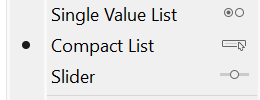This blog looks at what a parameter is, what the steps are to using a parameter and finally where it might be used. My next blog will walk through an example on Tableau.
What is a parameter?
A parameter is a value that can be changed by the user interacting with a view, rather than your visualizations using a constant value. Parameters allow you to give your users control over the visualization whether this be with a single value list, compact list or slider. Below shows what the options look like as well with some examples.


What are the steps to using a parameter?
- Create the parameter.- There are different properties for different data types: make sure you know what kind of parameter you want.
2. right click on the parameter and press show parameter.
3. Use the parameter in either a calculated field, reference line, set or filter- this will allow the data to be shown.
Where you might use Parameters?
- Reference lines.
- When you want to create multiple graphs in one and save space.
- Make data more interactive.
Difference vs a filter
- Filter will always remove data – a parameter may remove or may change data.
- Filter can be multi-select. Parameter is always single select.
- Can’t use a filter in a calculation
IMPORTANT: When you use parameters you need to tie them to the view in some way- otherwise your parameter will not affect data:
- You can use parameters in calculations and calculated fields that are used in the view.
- You can display the parameter control in the view for users to select parameters.
- You can reference parameters in parameter actions.
